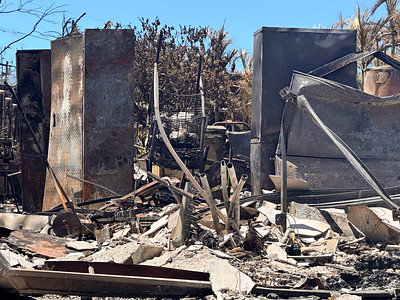Hawaiian Families Returning to Lahaina Residences After Wildfires
Catherine Anderson
Staff Writer
Residents of Lahaina, the historic town in Maui that was ravaged by wildfires on August 8, were allowed to visit the remains of their properties beginning on September 25, reports the Associated Press.
The first neighborhood to open for reentry was at the westernmost point of the burn zone, according to The New York Times. Visitation was initially limited to residents, people affiliated with property in the area, and any necessary people to accommodate them, such as insurance officials or religious leaders for support purposes, reports ABC News. In order to see their properties, The New York Times reports that authorities required Lahaina residents to show proof of residency and reentry permits. The New York Times also reports that authorities on Maui provided returners with masks and other personal protective equipment to protect them from potentially hazardous chemicals that could be present in the remains.
The Associated Press reports that some residents were allowed to assess the damages of their properties in the days immediately following the wildfire, which occurred on August 8, but following that, the area was completely restricted to everyone except for authorized workers. In addition to residents and authorities, some nonprofit and charitable groups were present to provide both emotional support and, in some cases, help survivors try to recover any possessions that remained in the ruins, reports the Associated Press.
A family that had been living in their Lahaina home since 1974, according to Hawaii News Now, was among the first group of survivors to visit their property. The Vierra family owned one of the first Lahaina homes ever built. The fire destroyed not only their home, Hawaii News Now reports, but most of their possessions and their three businesses. Despite this loss, the Vierras, and many other residents of Lahaina, hoped to find some life, and a sense of healing, by returning to the burn site.
Thousands of survivors of the fire, which Al Jazeera says took at least 97 lives, are currently living in temporary housing provided by the government. The fire also destroyed approximately 2,000 buildings, most of which were homes, reports the Associated Press. According to The New York Times, approximately 6,000 displaced residents are living in hotels in Maui and another 1,000 are living in Airbnbs and other similar short-term rentals. The government will continue to provide financial assistance for rent for 18 months, The New York Times reports.
The New York Times also writes that early estimates show that it could cost around $5.5 billion to rebuild West Maui. In addition to the physical damages, the fire also has significant economic impact, as it limits tourism, which is a major source of income for the island. The Hawaii Tourism Authority also approved a $2.6 million marketing campaign to encourage tourism to the island but asked that tourists avoid the burn zone out of respect, continues The New York Times. Additionally, the government is considering a moratorium on the purchase of damaged property in order to protect residents from having their land bought out by outsiders, says The New York Times.
The fire, and other recent natural disasters, have led to speculation regarding the role of global warming in these types of tragedies. Though climate change may have played a role in the severity of the fire, writes The Washington Post, it is far from the only factor. On the day of the fire, the Post continues, Hawaii was experiencing high winds, which contributed to the rapid spread of the fire. At the time, Hawaii was in the middle of a high-pressure weather system, which, along with “a flow of hot, dry air,” may have contributed to these high winds, writes The Washington Post. There were also drought conditions at the time, but The Post reports that climate change was not the direct cause of these.
Even though human-caused climate change did not cause the fires by itself, it likely played a role. The Washington Post writes that Hawaii is, on average, about two degrees hotter now than it was in 1950. Hotter temperatures do increase the likelihood of fires like the one in August, and while climate change may not have caused this specific tragedy, according to the Washington Post, it has certainly played a role in other recent tragedies, such as recent floods in China, fires in Greece, and extreme heat in the southern U.S.
Image courtesy of Flickr



